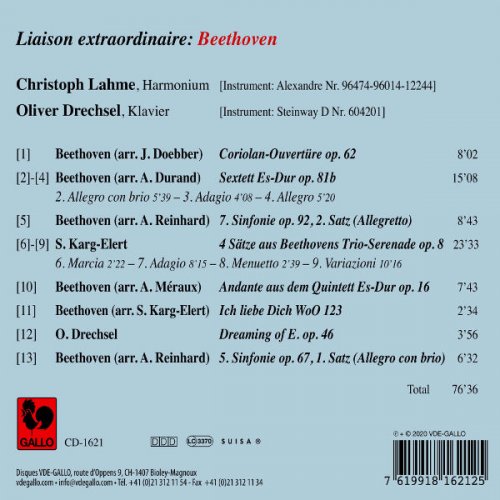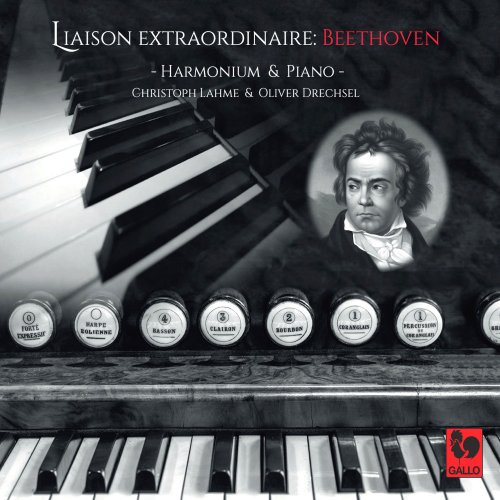
Christoph Lahme & Oliver Drechsel - Beethoven: Period Arrangements for Harmonium-Piano duo (2020)
BAND/ARTIST: Christoph Lahme, Oliver Drechsel
- Title: Beethoven: Period Arrangements for Harmonium-Piano duo
- Year Of Release: 2020
- Label: VDE-GALLO
- Genre: Classical
- Quality: flac lossless (tracks)
- Total Time: 01:16:36
- Total Size: 282 mb
- WebSite: Album Preview
Tracklist
01. Coriolan, Op. 62: Overture (Arr. by J. Doebber)
02. Sextet in E-Flat Major, Op. 81b: I. Allegro con brio (Arr. by A. Durand)
03. Sextet in E-Flat Major, Op. 81b: II. Adagio (Arr. by A. Durand)
04. Sextet in E-Flat Major, Op. 81b: III. Allegro (Arr. by A. Durand)
05. Symphony No. 7 in A Major, Op. 92: II. Allegretto (Arr. by A. Reinhard)
06. String Trio in D Major, Op. 8 "Serenade": I. Marcia (Arr. by S. Karg-Elert)
07. String Trio in D Major, Op. 8 "Serenade": II. Adagio (Arr. by S. Karg-Elert)
08. String Trio in D Major, Op. 8 "Serenade": III. Menuetto (Arr. by S. Karg-Elert)
09. String Trio in D Major, Op. 8 "Serenade": IV. Variazioni (Arr. by S. Karg-Elert)
10. Piano Quintet in E-Flat Major, Op. 16: II. Andante (Arr. by A. Méraux)
11. Zärtliche Liebe, WoO 123 "Ich liebe Dich" (Arr. by S. Karg-Elert)
12. Dreaming of E. Op. 46 (After Beethoven, für Elise, WoO 59)
13. Symphony No. 5 in C Minor, Op. 67: I. Allegro con brio (Arr. by A. Reinhard)

After numerous publications with original pieces for and with harmonium at the house of VDE-Gallo, latest of which were compositions of August Reinhard, we now present a new CD with another great domain of this instrument: the arrangement. And since the date of publication falls into the year 2020, the choice for a composer was not difficult at all. In our various concerts we had always been pleased with the beautiful and high quality arrangements of Beethoven’s compositions for our instrumentation, and a debut CD had been intended for quite some time. The Beethoven year was right on cue.
Rossini was not the first to recognize the advantages of combining harmonium and piano, however, his ‚Petite Messe Solennelle‘ is the most famous example of such a combination. Interesting is the fact that Rossini’s orchestral version of the Petite Messe was only arranged to prevent harmonic distortion by other orchestrating collegues. ‚Orchestration‘ is the key word which is quite often mentioned especially in connection with the harmonium. This feature qualifies the instrument especially for the interpretation of symphonic works.
Composer, harmonium builder and publisher Alphonse Mustel writes: You will surely agree with my conclusion that the Harmonium d’Art is, beyond any comparison, the only truly orchestral instrument; the single instrument can, by itself along, convey some the feeling of the massed instruments of the orchestra and imitate ar at least recall the details of their effect, in a word, the only instrument that may be considered as suggesting an orchestra in a reduced for, a chamber orchestra.
And Richard Strauss adds to the segment about the harmonium („Melodium“) in Berlioz’ instrumental guide the following: The Melodium is highly suited to arrangements of symphonic works for keyboard, violin and cello, as a substitute for the wind instruments. In France, this combination of instruments is often used in family circles for music-making at home and is decidedly more popular than the piano four-hand playing prefered by us.
As a suitable harmonium we chose an instrument of Alexandre, Paris, approx. 1880, which in its equippment and various contructural details is closely orientated to Mustel’s harmoniums. Its outer appearance and especially the original tone range lead to the conclusion that the instrument had been comissioned by a customer from Great Britain.
For our recording, various technical and tonal requirements had to be met: on one hand the accustic world of the an relatively early and simple instrument type, on which Durand based his arrangement for the Sextet during the 1850th, on the other hand Karg-Elert’s highly specialized arrangement of the Trio Serenade for a later harmonium. Karg-Elert’s registration references are as ususal very comprehensive and detailed; we followed these instructions as closely as possible. The other extreme is August Reinhardt, who provides absolutely no instructions concerning the registration; in fact, here we could and even had to improvise. Johannes Doebber only mentions the on- and off button of the Grand Jeu, however, writes those orchestral instruments into the musical score, which parts are just being played. Durand’s and Méreaux’s arrangements hold very few registration specifics and are limited to basics. Re-registrations are rare and those few which appear are the registers 1-4. In Mustel’s standard piece L’Orgue Expressif ou L’Harmonium he allows the performer artistic freedom of choice regarding selection and mixture of tone colour. Ever so often we chose colours different from those specified by Alexandre’s harmonium. Regarding artistic freedom of choice: Karg-Elert arranges only 4 movements for the Trio Serenade and ends the work with variations. After the last variation the theme shall be repeated. However, we decided to stay with Beethoven’s original and play No.1 MARCIA da capo.
Dreaming of E. by Oliver Drechsel was originally composed for the pianist Susanne Kessel, Bonn, for her international composition project „250 piano pieces for Beethoven„. Creative sponsor for this composition was none other than film director Arthur Brauner (Europa Europa -Hitlerjunge Salomon ), who had turned 100 years old exactly on the creative birthdate of this compositon. The melancholic composition, which reminds of a movie score waltz is based on the first few notes of Beethoven’s ‚Für Elise‘ WoO 59, and is due to its polyphonic arrangement well suited for an adaption with harmonium and piano. When in the original composition the hopeful turn to C-Dur takes place, sublimally under the ‚For Elise‘ melody the beginning of Beethoven’s love song „Zärtliche Liebe“ WoO 123 breaks through and becomes the brief constrasting middle part. The end of the dream remains open….
01. Coriolan, Op. 62: Overture (Arr. by J. Doebber)
02. Sextet in E-Flat Major, Op. 81b: I. Allegro con brio (Arr. by A. Durand)
03. Sextet in E-Flat Major, Op. 81b: II. Adagio (Arr. by A. Durand)
04. Sextet in E-Flat Major, Op. 81b: III. Allegro (Arr. by A. Durand)
05. Symphony No. 7 in A Major, Op. 92: II. Allegretto (Arr. by A. Reinhard)
06. String Trio in D Major, Op. 8 "Serenade": I. Marcia (Arr. by S. Karg-Elert)
07. String Trio in D Major, Op. 8 "Serenade": II. Adagio (Arr. by S. Karg-Elert)
08. String Trio in D Major, Op. 8 "Serenade": III. Menuetto (Arr. by S. Karg-Elert)
09. String Trio in D Major, Op. 8 "Serenade": IV. Variazioni (Arr. by S. Karg-Elert)
10. Piano Quintet in E-Flat Major, Op. 16: II. Andante (Arr. by A. Méraux)
11. Zärtliche Liebe, WoO 123 "Ich liebe Dich" (Arr. by S. Karg-Elert)
12. Dreaming of E. Op. 46 (After Beethoven, für Elise, WoO 59)
13. Symphony No. 5 in C Minor, Op. 67: I. Allegro con brio (Arr. by A. Reinhard)

After numerous publications with original pieces for and with harmonium at the house of VDE-Gallo, latest of which were compositions of August Reinhard, we now present a new CD with another great domain of this instrument: the arrangement. And since the date of publication falls into the year 2020, the choice for a composer was not difficult at all. In our various concerts we had always been pleased with the beautiful and high quality arrangements of Beethoven’s compositions for our instrumentation, and a debut CD had been intended for quite some time. The Beethoven year was right on cue.
Rossini was not the first to recognize the advantages of combining harmonium and piano, however, his ‚Petite Messe Solennelle‘ is the most famous example of such a combination. Interesting is the fact that Rossini’s orchestral version of the Petite Messe was only arranged to prevent harmonic distortion by other orchestrating collegues. ‚Orchestration‘ is the key word which is quite often mentioned especially in connection with the harmonium. This feature qualifies the instrument especially for the interpretation of symphonic works.
Composer, harmonium builder and publisher Alphonse Mustel writes: You will surely agree with my conclusion that the Harmonium d’Art is, beyond any comparison, the only truly orchestral instrument; the single instrument can, by itself along, convey some the feeling of the massed instruments of the orchestra and imitate ar at least recall the details of their effect, in a word, the only instrument that may be considered as suggesting an orchestra in a reduced for, a chamber orchestra.
And Richard Strauss adds to the segment about the harmonium („Melodium“) in Berlioz’ instrumental guide the following: The Melodium is highly suited to arrangements of symphonic works for keyboard, violin and cello, as a substitute for the wind instruments. In France, this combination of instruments is often used in family circles for music-making at home and is decidedly more popular than the piano four-hand playing prefered by us.
As a suitable harmonium we chose an instrument of Alexandre, Paris, approx. 1880, which in its equippment and various contructural details is closely orientated to Mustel’s harmoniums. Its outer appearance and especially the original tone range lead to the conclusion that the instrument had been comissioned by a customer from Great Britain.
For our recording, various technical and tonal requirements had to be met: on one hand the accustic world of the an relatively early and simple instrument type, on which Durand based his arrangement for the Sextet during the 1850th, on the other hand Karg-Elert’s highly specialized arrangement of the Trio Serenade for a later harmonium. Karg-Elert’s registration references are as ususal very comprehensive and detailed; we followed these instructions as closely as possible. The other extreme is August Reinhardt, who provides absolutely no instructions concerning the registration; in fact, here we could and even had to improvise. Johannes Doebber only mentions the on- and off button of the Grand Jeu, however, writes those orchestral instruments into the musical score, which parts are just being played. Durand’s and Méreaux’s arrangements hold very few registration specifics and are limited to basics. Re-registrations are rare and those few which appear are the registers 1-4. In Mustel’s standard piece L’Orgue Expressif ou L’Harmonium he allows the performer artistic freedom of choice regarding selection and mixture of tone colour. Ever so often we chose colours different from those specified by Alexandre’s harmonium. Regarding artistic freedom of choice: Karg-Elert arranges only 4 movements for the Trio Serenade and ends the work with variations. After the last variation the theme shall be repeated. However, we decided to stay with Beethoven’s original and play No.1 MARCIA da capo.
Dreaming of E. by Oliver Drechsel was originally composed for the pianist Susanne Kessel, Bonn, for her international composition project „250 piano pieces for Beethoven„. Creative sponsor for this composition was none other than film director Arthur Brauner (Europa Europa -Hitlerjunge Salomon ), who had turned 100 years old exactly on the creative birthdate of this compositon. The melancholic composition, which reminds of a movie score waltz is based on the first few notes of Beethoven’s ‚Für Elise‘ WoO 59, and is due to its polyphonic arrangement well suited for an adaption with harmonium and piano. When in the original composition the hopeful turn to C-Dur takes place, sublimally under the ‚For Elise‘ melody the beginning of Beethoven’s love song „Zärtliche Liebe“ WoO 123 breaks through and becomes the brief constrasting middle part. The end of the dream remains open….
Year 2020 | Classical | FLAC / APE
As a ISRA.CLOUD's PREMIUM member you will have the following benefits:
- Unlimited high speed downloads
- Download directly without waiting time
- Unlimited parallel downloads
- Support for download accelerators
- No advertising
- Resume broken downloads


